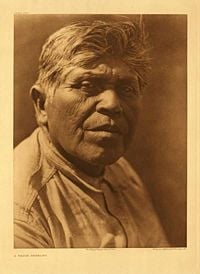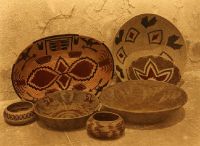Serrano (people)
The Serrano are a Native American tribe of Southern California. They refer to themselves as the Yuhaviatam, which means "people of the pines." The Serrano historically populated the San Bernadino Mountains and extended down to the Mojave River region down to the Tejon Creek.
History
Serrano people traditionally lived in the Mojave River and San Bernadino Mountains of Southern California. The Spanish explorers and missionaries called them Serrano meaning highlanders, but they refer to themselves as Yuhaviatam, "people of the pines."
Members of the Serrano tribe are part of the Shoshonean subset of the Uto-Aztecan group of Native Americans. They were an offshoot of the Takic people that arrived in Southern California around 2,500 years ago. When the Spanish missionaries came into the region, they helped form the tribal name Serrano, separating them from their neighbors that were designated as the Gabrielino and Kitanemuk.
Estimates for the pre-contact populations of most native groups in California have varied substantially. Alfred L. Kroeber (1925) put the combined 1770 population of the Serrano, Kitanemuk, and Tataviam at 3,500 and the Serrano proper (excluding the Vanyume) at 1,500. Lowell John Bean suggested an aboriginal Serrano population of about 2,500 (Bean and Smith 1978). Kroeber estimated the combined population of the Serrano, Kitanemuk, and Tataviam in 1910 as 150.
Mission San Gabriel Arcangel was founded in 1771 and the Serrano revolted against the missions along with the Cahuilla and Yuma tribes in 1812. In 1834 many Serrano were forcibly relocated to the missions. The term Mission Indians applied to the Serrano and other tribes originates from the missions established by the Spanish along the coast of California between 1769 and 1823. In the missions many died as a result of disease. They suffered devastating smallpox outbreaks in both 1840 and 1860.
The California Gold Rush of 1849 dramatically changed the way of life of the Serrano. The influx of settlers whose mining, farming, and logging changed the lands disrupted their traditional lifestyle.
In 1866, militia forces from San Bernardino killed Serrano men, women, and children in a 32-day campaign. Yuhaviatam tribal leader Santos Manuel (from whom the name San Manuel Band of Mission Indians comes) led the remaining Yuhaviatam from the mountains to the safety of the valley floor. The reservation was established in 1891.
Culture
San Bernardino's earliest known inhabitants were the Serrano (Spanish for "people of the mountains") who spent their winters in the valley, and their summers in the cooler mountains. Towns in the area bear the names of their settlements—Yucaipa, Cucamonga, and Muscupiabe.
They lived in small, brush covered, communal wickiups. These were circular, and measured 12 feet (3.7 m) to 14 feet (4.3 m) across and constructed with willow framing and tule thatching. They were built in an area that had been excavated as much as 2 feet (0.61 m). A pit lined with stones was dug in the center to serve as the fireplace.
Their villages consisted of ten to thirty such structures that the Spanish named rancherías. They crafted baskets and vessels with mother-of-pearl inlays which were often traded to the native people in the Santa Barbara region. The men did not wear clothing and the women wore deerskin, otter, and rabbit furs.
The Serrano that inhabited the San Bernadino mountains would go to the valleys of Apple Valley and Lucerne during the winter and the area in and around Big Bear Lake during the summer. They hunted small game like rabbits utilizing traps along with bows and arrows. They did not hunt the Grizzly Bears which they believed were reincarnations of their ancestors spirits. They were skilled craftsmen, experts in basketweaving.
Their diet consisted of the game that they caught as well as pinon nuts ground into a dough and made into a flat tortilla like food. They also ate the acorns from the oak trees to make a flour and then a type of porridge. Other staples were roasted agave, prickly pears, and Yucca blossoms.
Traditionally Serrano were divided into two moieties, with exogamous marriage (marriage to a member of the other group).
Traditional beliefs
Serrano traditional narratives include myths, legends, tales, and oral histories. Serrano oral literature is closely linked with the traditions of the Serrano's closest linguistic relatives, the Takic-speaking groups to their south, as well as with the traditions of the Yuman-speaking groups. These relationships are particularly evident in the sharing of the distinctive Southern California Creation Myth.
The grizzly bear was held in deep reverence, regarded as an ancestor. The Serrano never ate bear meat, nor used their furs. Ceremonies were held to to honor the dead, fiestas with food, gifts, ritual singing and dancing, that lasted for several days. They cremated their dead, rather than burying them, and burned their possessions. A location near Big Bear City contains petroglyphs on the rocks and artifacts indicating its use as a ceremonial ground.
Contemporary Serrano
The San Manuel Band of Mission Indians in Highland, California are contemporary Serrano. Many of the residents of the Morongo Reservation, some Template:Convert/miles away, are also of Serrano descent.
Few people speak the Serrano language, and few traditional rituals survive. However, many efforts have been made to revive interest in the traditional culture.
The San Manual Band turned to gaming to create jobs and generate revenue. Beginning with bingo in 1986, the tribe obtained government revenue and expanded the enterprise in 1994 to include a 100,000 square foot casino including a card room and slot machines. Further expansion followed and by 2008 the San Manuel Indian Bingo and Casino employed over 2,500 people. Based on this success, the San Manuel Band of Mission Indians has made great improvements in their community, working to overcome the problems of unemployment, alcohol and drug abuse, and low educational attainment. The gaming activities have been conducted so that revenues can be used to strengthen tribal government and to maintain an independent and self-sustaining economy (Marquez 2005).
The San Manuel Band enacted an education ordinance providing tuition and other support for members to pursue their education. Healthcare has been dramatically improved from the days still recalled by tribal elders when once a month a medical doctor made a stop on their reservation. In the 19070s a small clinic was established and a larger facility was available on the Morongo Reservation. Today, a comprehensive health care plan is available as well as encouragement for preventive measures, including the building of a fitness facility in the community center on the reservation (Marquez 2005).
Efforts have also been made to preserve traditional culture and language. A spring celebration, Yaamar'a, is held each year. A language program has been instituted to teach the language to young tribal members, and many educational materials have been developed to assist the teaching of tribal history and culture (Edwards 2006). An annual three-day pow-wow is held at California State University San Bernadino in October. This event includes competitions for dancing, drumming, and singing, and is open to all, Serrano, Native Americans of other tribes, and others alike.
ReferencesISBN links support NWE through referral fees
- Bean, Lowell John, and Charles R. Smith. 1978. "Serrano" In California. Edited by Robert F. Heizer. pp. 570-574. Handbook of North American Indians. William C. Sturtevant, general editor. Vol. 8. Smithsonian Institution, Washington, D.C.
- Kroeber, A. L. 1925. Handbook of the Indians of California. Bureau of American Ethnology Bulletin No. 78. Washington, D.C.
- Benedict, Ruth. 1926. "Serrano Tales," Journal of American Folklore 39:1-17.
- Gifford, Edward Winslow. 1918. "Clans and Moieties in Southern California," University of California Publications in American Archaeology and Ethnology 14:155-219.
- Margolin, Malcolm. 1993. The Way We Lived: California Indian Stories, Songs, and Reminiscences. Berkeley, CA: Heyday Books.
- Mount, Guy. 1993. Serrano Songs and Stories. Cottonwood, CA: Sweetlight Books.
- Edwards, Andrew. 2006. Saving the Serrano tongue. The Sun: San Bernadino and the Inland Empire. Retrieved October 16, 2008.
- Marquez, Deron. 2005. Before the Senate Committee on Indian Affairs Retrieved October 20, 2008.
External links
Credits
New World Encyclopedia writers and editors rewrote and completed the Wikipedia article in accordance with New World Encyclopedia standards. This article abides by terms of the Creative Commons CC-by-sa 3.0 License (CC-by-sa), which may be used and disseminated with proper attribution. Credit is due under the terms of this license that can reference both the New World Encyclopedia contributors and the selfless volunteer contributors of the Wikimedia Foundation. To cite this article click here for a list of acceptable citing formats.The history of earlier contributions by wikipedians is accessible to researchers here:
The history of this article since it was imported to New World Encyclopedia:
Note: Some restrictions may apply to use of individual images which are separately licensed.

